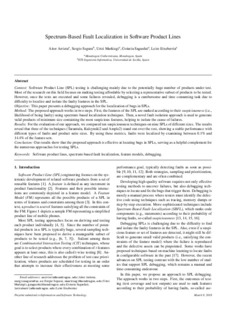Izenburua
Spectrum-based fault localization in software product linesEgilea (beste erakunde batekoa)
Bertsioa
Postprinta
Eskubideak
© 2018 Elsevier B. V.Sarbidea
Sarbide bahituaArgitaratzailearen bertsioa
https://doi.org/10.1016/j.infsof.2018.03.008Non argitaratua
Information and Software Technology Vol. 100. Pp. 18-31. August,Lehenengo orria
18Azken orria
31Argitaratzailea
Elsevier B. V.Gako-hitzak
Software product linesSprectum-based fault localization
Feature models
Debugging
Laburpena
Context:
Software Product Line (SPL) testing is challenging mainly due to the potentially huge number of
products under test. Most of the research on this field focuses on making testing affordable ... [+]
Context:
Software Product Line (SPL) testing is challenging mainly due to the potentially huge number of
products under test. Most of the research on this field focuses on making testing affordable by selecting a
representative subset of products to be tested. However, once the tests are executed and some failures revealed,
debugging is a cumbersome and time consuming task due to difficulty to localize and isolate the faulty features
in the SPL.
Objective:
This paper presents a debugging approach for the localization of bugs in SPLs.
Method:
The proposed approach works in two steps. First, the features of the SPL are ranked according to their
suspiciousness (i.e., likelihood of being faulty) using spectrum-based localization techniques. Then, a novel fault
isolation approach is used to generate valid products of minimum size containing the most suspicious features,
helping to isolate the cause of failures.
Results:
For the evaluation of our approach, we compared ten suspiciousness techniques on nine SPLs of different
sizes. The results reveal that three of the techniques (Tarantula, Kulcynski2 and Ample2) stand out over the rest,
showing a stable performance with different types of faults and product suite sizes. By using these metrics, faults
were localized by examining between 0.1% and 14.4% of the feature sets.
Conclusion:
Our results show that the proposed approach is effective at locating bugs in SPLs, serving as a helpful
complement for the numerous approaches for testing SPLs [-]





















